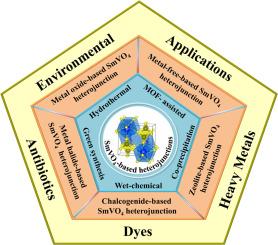探索提高smvo4基异质结形成光催化活性的水净化策略
IF 6.3
3区 工程技术
Q1 ENGINEERING, CHEMICAL
Journal of the Taiwan Institute of Chemical Engineers
Pub Date : 2025-09-12
DOI:10.1016/j.jtice.2025.106394
引用次数: 0
摘要
在光催化领域中,半导体异质结作为一种有前途的策略,已经引起了科学界的广泛关注,以促进环境弹性发展,实现长期的世代利益。这种方法被认为是缓解当前环境危机的有效办法。钒酸钐(SmVO4)是一种极具吸引力的稀土金属正钒酸盐,由于其最佳能带位置和窄带隙,从而扩大了可见光区域的吸收能力,一直是太阳能驱动应用的焦点。方法为了满足广泛的光催化应用需求,裸光催化剂由于其高复合率、团聚、低比表面积等局限性而效果不佳。因此,研究人员探索并实施了各种策略来减轻上述缺点,提高整体光催化性能。为了填补这一空白,本文系统地阐述了晶体学、电子学和光学性质,然后介绍了合成方法。然后,分析了改性策略,即通过将裸SmVO4与其他半导体(如金属氧化物、无金属、金属卤化物、金属有机骨架、绝缘材料等)集成形成异质结。该方法增加了表面面积,化学稳定性,促进了电荷偏析能力,提供了更多的活性位点,并表现出高量子效率。通过基于smvo4的异质结,研究了各种光催化应用,包括抗生素、染料和重金属降解,符合联合国可持续发展目标-6,即清洁水和卫生设施。最后,文章总结了基于smvo4的异质结在可持续生活中的关键问题和未来发展方向。本文章由计算机程序翻译,如有差异,请以英文原文为准。

Exploring strategies for enhancing photocatalytic activity of SmVO4-based heterojunctions formation for water purification
Background
Semiconductor-based heterojunctions in the realm of photocatalysis has attracted significant consideration among scientific community as a promising strategy to advance environmentally resilient development for long-term generational benefit. This approach has been acknowledged as an effective solution to ameliorate the ongoing environmental crisis. Samarium vanadate (SmVO4), a fascinating rare earth metal orthovanadate, has been the focal point in the solar-driven applications due to optimal band positions and a narrow band gap, thereby broadening the absorption capacity within the visible light region. It also acts as a highly effective photocatalyst for many reactions, such as the dehydrogenation of alkanes, olefins, etc.
Methods
To address the broad spectrum of photocatalytic application demands, the bare photocatalyst is ineffective owing to its limitations, such as high recombination rate, agglomeration, low surface area, etc. Therefore, various strategies were explored and implemented by the researchers to mitigate the above-mentioned shortcomings and to improve the overall photocatalytic performance. To fill this gap, the review systematically elucidates the crystallographic, electronic and optical properties, followed by synthesis methods. Thereafter, modification strategy i.e., heterojunction formation via integrating bare SmVO4 with other semiconductors such as metal oxide, metal-free, metal halide, metal organic frameworks, insulating material and more was analysed.
Significant findings
This approach increases the surface area, chemical stability, facilitates the charge-segregation capability, offers more active sites and exhibits high quantum efficiency. The various photocatalytic applications, including antibiotic, dye, and heavy metal degradation via SmVO4-based heterojunctions were examined, aligning with the United Nations Sustainable Development Goals-6 i.e., clean water and sanitation. Finally, the article concluded with key issues and future directions related to SmVO4-based heterojunctions for sustainable living.
求助全文
通过发布文献求助,成功后即可免费获取论文全文。
去求助
来源期刊
CiteScore
9.10
自引率
14.00%
发文量
362
审稿时长
35 days
期刊介绍:
Journal of the Taiwan Institute of Chemical Engineers (formerly known as Journal of the Chinese Institute of Chemical Engineers) publishes original works, from fundamental principles to practical applications, in the broad field of chemical engineering with special focus on three aspects: Chemical and Biomolecular Science and Technology, Energy and Environmental Science and Technology, and Materials Science and Technology. Authors should choose for their manuscript an appropriate aspect section and a few related classifications when submitting to the journal online.

 求助内容:
求助内容: 应助结果提醒方式:
应助结果提醒方式:


